Hot chestnut honey, smoky leather, waxed woods… This may sound like a perfume description, but what I’m talking about is tea, and to be more precise, Yunnan d’Or tea from Le Palais des Thés. As I sniff the amber colored liquid in my cup, I get a bright and sparkling top note of sticky buds and caramel, but a sip reveals a voluptuous leathery richness. It’s a revelation. I knew that tea, like wine, chocolate and other complex flavors, has numerous layers, but to experience a perfume pyramid in a tea cup feels exciting.
I’ve been a fan of Le Palais des Thés tea for more than 10 years, ever since I discovered their velvety and seductive Pettiagalla, a black tea from Sri Lanka, at a small tea shop in San Francisco. This French tea importer has made an impressive reputation for itself thanks to the top quality of its teas. François-Xavier Delmas, the founder of Le Palais des Thés, travels around the world with his team and selects the most interesting varieties and he documents his adventures at Discovering Tea, his tea traveler’s blog. As with wine, the quality of the soil and the weather can affect the tea’s flavor, and such attention to detail insures the constant supply of unusual blends.
But what made me even more curious about Le Palais des Thés was their famous Tea School. L’Ecole du Thé is run by Carine Baudry, an ISIPCA trained nose and a good friend of perfumer Mathilde Laurent whose dark and moody Cartier XIII La Treiziéme Heure was inspired by smoky black teas. My search led me to the Le Palais des Thés showroom in New York, where I was given a brief lesson on brewing and tasting tea by Aurélie Bessière, president of the company’s American branch. While systematic courses like those offered to tea lovers in Paris aren’t yet available in the States, the company will organize a tasting by request and is planning to expand its course offerings. I certainly hope that this happens soon, because the classes about specific types of teas and tea and food pairings—Aurélie mentions that their tea and cheese course has been very popular—as well as the opportunities to travel to tea plantations sound fascinating.
I learn very quickly when we start tasting tea that the proper way of brewing tea is crucial to experience the full flavor profile, but there are several ways to do it, and the process isn’t particularly intricate. Dark teas like Yunnan or Qimen that tastes of malt and autumnal leaves can take up to 5 minutes of steeping in hot water, while the more delicate white and green teas require a lower temperature. In China, however, the tea leaves are sometimes covered with water and given a short steep and drained into a cup, before the procedure is repeated. This way, each cup of tea tastes differently—the first one will capture the floral top notes, the second will reveal the fruity heart, while the subsequent ones capture the vegetal or woody aromas. Full steeping, by contrast, presents the complete spectrum of tea flavors in one sip.
For me Aurélie brews Yunnan d’Or following the standard practice—2g (approximately 1.5 teaspoons) of tea steeped for 4 minutes in 100ml of almost boiling (195F) water to fully extract the flavor. She recommends avoiding metal tea balls, which prevent leaves from unfurling and releasing their aromas. Le Palais des Thés packaging indicates the appropriate time and water temperature for each tea, but as Aurélie mentions you can also experiment to create lighter or darker blends. She deftly drains a small white tea pot into the cup and encourages me to take a sip, but not to swallow it right away. As I roll the liquid around my mouth, I notice more flavors—a walnut shell, a hint of caramel, a dried rose. The aftertaste is tannic and rich, and I can distinctly taste the woody notes that make me think of polished wood.
When we sample Aiguilles d’Argent, a white tea made from fine tips and buds, the experience is completely different. Called Silver Needles or “Yin Zhen” in Chinese, this tea has an exquisite flavor of ripe green grapes and a sheer jasmine finish. The perfume rising from the cup is so lovely that I’m not sure if I want to drink this tea or dab it on my wrists. Beautiful and delicate teas like Aiguilles d’Argent are best drunk on their own to fully enjoy the flavor, but Aurélie mentions that more robust teas pair perfectly with food. Smoky tea infusions can be used in marinades for fish or meat. Dry leaves can be crushed with salt and pepper and used to encrust a steak before grilling. Olive oil infused with tea leaves is a rich accent for salads and dressings. “You can even use dark tea instead of other liquids in your chocolate cake recipes,” mentions Aurélie, and I begin to imagine the possibilities of chocolate mousse whipped with rose tea or red velvet cake flavored with malty Chinese Qimen blends.
In the days following my tea lesson, I apply my learning to everything in my tea cupboard. I even discover the pleasant tannic notes in Lipton that I save for making Indian style chai. The Japanese bancha made from coarse twigs and leaves has the perfume of an antique wooden box and barnyard. Then I reach for Hermès Osmanthe Yunnan in my perfume cabinet and have an epiphany—under the apricot skin and jasmine sweetness of osmanthus, I notice the same soft leather and waxed woods note that attracted me to Le Palais des Thés’s Yunnan d’Or. I believe that I have come full circle in my tea and perfume quest.
Photography by Bois de Jasmin, all rights reserved.
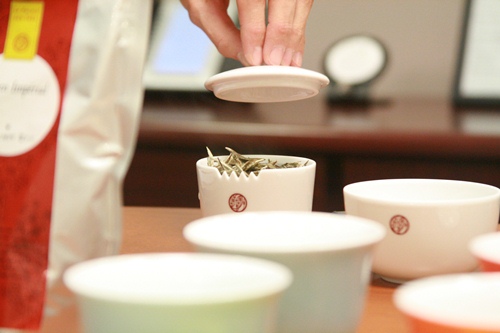
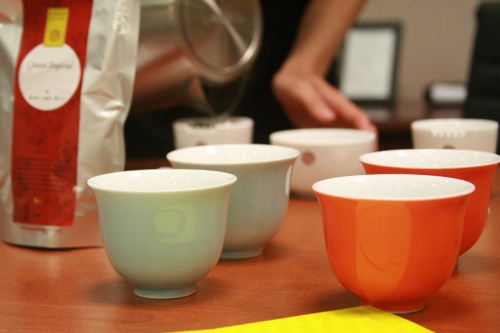
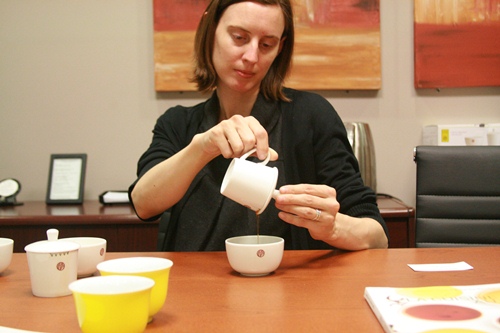
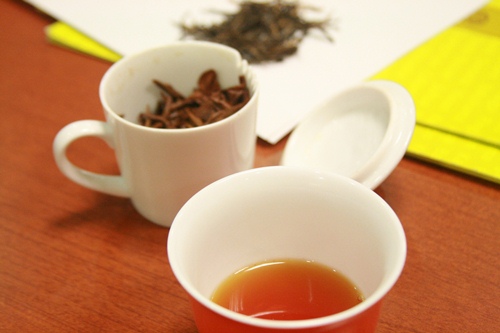
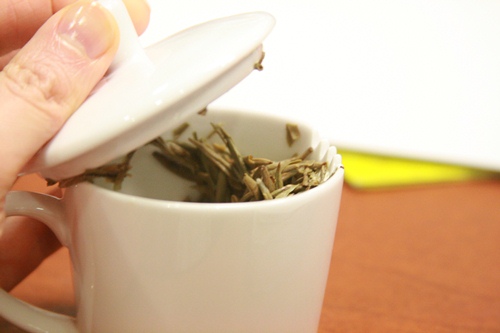
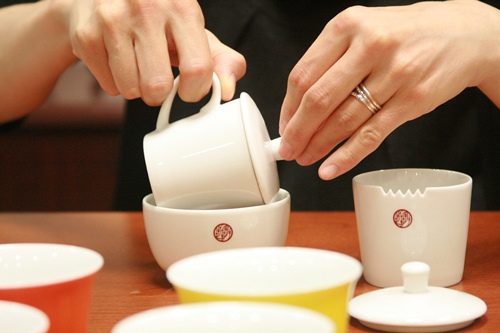
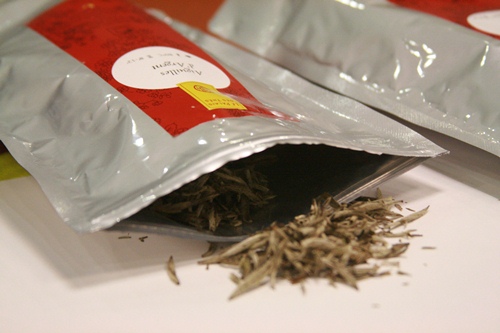















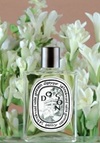

42 Comments
Martyn: Teas! At one time I used to drink mug after mug of strong tea with milk, usually made with fermented leaves in a teabag. But several years ago I began to find that tea like this made me nauseous, and for a while I only drank coffee. Then, in London’s Shepherd’s Market one day, I discovered Silver Needle, and this opened my taste-buds to the beauty of unfermented teas. I’m convinced, too, that a major part of my enjoyment is the fragrance that rises from the cup. June 7, 2012 at 7:35am
Victoria: Martyn, I can relate to this. Extremely strong tea (especially fermented varieties) can affect me similarly, so I try to make sure that I never drink them on an empty stomach and never first thing in the morning.
Apropos to this, a friend who practices Chinese medicine explained once to me that generally green teas are best drunk later in the day, because they are too “cold” for the body first thing in the morning. This idea of hot vs cold is central to the Chinese understanding of bodily humors (and very similar to Ayurveda in some respects). But I guess that some people have so much heat in their system that the opposite is true. So, like you I found that the Silver Needle tea was an ideal morning beverage. It’s also high enough in caffeine to give a pleasant boost. I still haven’t purchased the variety I drank at the LPdT lesson, but I think that it will be my next tea purchase. It was just so fragrant and complex. June 7, 2012 at 7:50am
Sara: Thanks for this lovely story and beautiful photographs! I haven’t tried any Le Palais des Thes teas… really should sample more. My favorite teas keep changing: these days I drink more English Breakfast, but I also like oolongs. June 7, 2012 at 10:33am
Victoria: I’m a big fan of their teas, and while I tasted only a small part of their collection, I enjoyed everything I came across. Pettiagalla is the tea I buy in 1lb bags, because everyone in my family loves it. Yunnan d’Or and Silver Needles that I tasted during the lesson were new to me, but I liked them very much. June 7, 2012 at 11:47am
Elizabeth: My boyfriend adores Chinese tea! His favorite is Pu-er, which is as malty and smoky as scotch. It’s one of the best teas to drink with Dim Sum, because it is said to aid in digestion. He also likes Ti Kuan Yin, which tastes a bit like orchid, and Flowery Oolong. I’m not quite as sophisticated in my drink choices. I prefer coffee, but when I drink tea it’s usually English Breakfast with some lemon in it. June 7, 2012 at 10:33am
Victoria: I need to give Pu-erh another try. I absolutely love the perfume of this tea whether in a dry form or when brewed, but the flavor has often been too strong for me. I’ve also discovered that I might be oversteeping it. June 7, 2012 at 11:48am
Victoria: Oh, and I wanted to add that some varieties of Ti Kuan Yin taste distinctly of lilac to me, which is so unexpected. June 7, 2012 at 11:49am
Lindsey: Hello. I’ve been a lurker for a long time and want to say I love your posts. You make me curious to try new things. I like black tea, so I really should try Yunnan d’Or. I don’t drink/like green teas, but maybe it’s because I haven’t sampled enough. June 7, 2012 at 10:51am
Victoria: Thank you very much, Lindsey!
Yunnan d’Or was an instant love for me–it’s rich, full-bodied and has such a beautiful flavor. If you like black teas in general, you might enjoy it too.
It took me a while to start enjoying green teas, and what I discovered is that most bagged green teas are really not that great. Also, green tea is very sensitive to water temperature and steeping time. If oversteeped, it becomes very bitter. So, yes, I definitely recommend sampling more and experimenting with steeping times. June 7, 2012 at 11:52am
Ruth: Lindsey, I’ve lurked here for a while too, and you’ve perfectly captured my experience with Victoria’s posts! If you’re curious about tea, I would highly recommend Upton Tea Imports. Their array of teas, and extensive notes on the tea estates and growing conditions are an education. They have nicely priced small tasting packets too. June 7, 2012 at 8:41pm
Victoria: Thank you for your recommendation, Ruth. I agree that Upton Tea has an interesting variety. I am drinking their green tea scented with rose and jasmine right now, and the flavor is delicate but rich. June 8, 2012 at 5:08am
Lindsey: Thank you! I didn’t know about Upton Tea Imports either. So many new things to try.
Victoria, I would love to know more about that rose and jasmine green tea. June 8, 2012 at 9:52am
Victoria: Lindsey, sorry, I just realized that looking at my packet that it’s just a rose scented green tea, but I added some dried jasmine flowers into it later.
On Upton’s website, the tea is sold as TP46: Rose Green Tea Organic. If you like rose flavored tea, it’s a good choice. TP42: China Rose Special Chun Mee is also very nice. These are green teas though, and you’ve mentioned that you aren’t a fan of green teas. I haven’t tried any other flavored teas from Upton, but maybe those who have can comment. June 8, 2012 at 10:20am
iodine: I appreciate your blog more and more each day!
I love tea for its flavour but lately I’m thinking that I prefer smelling tea leaves than drinking the brew!
I like green Chinese teas, mostly, and Oolong, natural or traditionally perfumed, like Osmanthus or Milky oolong- the milk effect is obtained with white flowers essences, I guess.
A couple of times, in France, I experienced the Gongfu ceremony and it was very intense, involving all the senses. I wish there were more places like the one you describe all over the world!
it’s five o’clock, here in Italy, right time for a nice cup of tea! June 7, 2012 at 11:06am
Victoria: Glad that you enjoyed the post.
Aurelie did talk about the Gongfu cha ceremony/method of tea brewing, and it sounded very interesting. I had no idea that the same type of tea could be steeped in so many different ways. She also mentioned that people in some parts of China simply add tea leaves to their mugs and refill them with water during the course of the day. This way, you also get different flavor fractions in each cup.
I love Chinese teas in general, but Taiwanese oolongs are at the top of my list. June 7, 2012 at 11:55am
Jillie: Absolutely lovely description, Victoria – I could almost smell the teas, and I laughed when you said you didn’t know whether to wear or taste the gorgeous liquid.
Here in the UK I have lately discovered a delicious flaked sea salt that has ground green tea, coriander and rose petals added to it. Sprinkling it over roast potatoes and vegetables adds another dimension to taste. Sadly, it seems that, as usual, my liking for something has sealed its fate, as the producers have just informed me that they are discontinuing it as not enough people bought it! I shall have to concoct my own version …… June 7, 2012 at 11:38am
Victoria: Jillie, the tea was so fragrant! 🙂
the sea salt and tea mixture sounds wonderful! I would love to recreate it, so please let me know how your experiment goes. I can just imagine how delicious this salt would be on grilled fish or even on courgette/zucchini. June 7, 2012 at 11:58am
Martyn: Victoria wrote: “I would love to recreate it, so please let me know how your experiment goes.”
Me too! And could you let me know, please, who they are, so I might perhaps find some before it’s all gone? June 8, 2012 at 9:06am
Anatole: I’m glad you enjoyed your tea lesson! I work for Le Palais des thés and can confirm as a perfumista, that there’s a all bridge between perfume and tea. (And I highly recommand the trainings with Carin Baudry, for any perfumista it’s honey. She’s really passionnate and her teachings are easy to follow and you learn so much about tea, you’ll never drink and smell a tea the same way after.) June 7, 2012 at 12:13pm
Victoria: What a great job you have! To be surrounded by all of those teas and scents…
I read a very interesting interview with Carine Baudry in the ISIPCA alumni magazine some time ago, and I loved the way she talked about her job. She seemed to genuinely love it. June 7, 2012 at 1:27pm
Andy: What a coincidence that as I read this I was about to get a cup of my favorite jasmine silver needle tea. I am obsessed with tea and through the years have learned so much about how to make a good cup. Using good quality loose leaf tea and high quality water is so important, as is being cognizant of water temperature. It’s funny that, somehow or another, I haven’t yet tried any teas from Le Palais des Thés. I’ve heard so many good things about them too. I will have to remedy that soon by purchasing some teas from them. I always brew my tea in a gaiwan (the vessel where the tea is steeped in the gongfu style) and have found that it is far superior to using a traditional teapot. Also I find that it is certainly accurate to say that tea and perfume are connected. The aromas of teas are so enticing and very complex. In fact, I choose my tea each day in the same manner one chooses what perfume they might wear—I narrow down the choices based on my mood, and then choose from there, often taking a sniff of each one to choose. June 7, 2012 at 12:40pm
Victoria: Aurelie mentioned that in France Volvic water is considered to be one of the best for making tea. I think that I saw this brand in the States too.
I used to think that the talk about the quality of water was just something arcane, but I’ve smelled the same perfume blended with two different waters and observed how much difference it makes (there is always a bit of water added to perfume oil, mixed in with alcohol). I can believe that it would make a big difference for tea. June 7, 2012 at 1:31pm
Nancy: More and more we learn of the beneficial properties of tea but the way you characterized the pleasures of its aromatics draws me to new investigation and several failed attempts to consider replacing tea with my love of coffee. There’s also a great comforting quality to tea. And somewhere, it’s been said that Yunnan is possibly the Queen and Assam is the King or is it in the reverse. Nonetheless, I will seek out Palais des The for I am open to all possibilities. I remember Mariages Freres, which had a tea salon years prior but no longer around and then there was the tea salon at Takashamiya –again long gone. There’s a beautiful and bountiful tea shop/boutique in Chinatown but rather pricey! Any suggestions for tea salons and stores for discovery? Thanks for this article! June 7, 2012 at 1:00pm
Victoria: I’m still mourning the loss of Takashimaya, Nancy. For a good tea salon/shop in NYC, I would recommend Harney and Sons in Soho. I also like the store in Grand Central calling Tea & Honey. That’s where I buy my Le Palais des Thes tea as well, even though they don’t carry the full selection. June 7, 2012 at 1:35pm
Austenfan: I was thrilled to read this post. I adore Yunnan tea and actually have a tin of Yunnan d’Or. It is quite a robust Yunnan. I am now drinking Yunnan Dian Hong from Betjeman&Barton, which is really lovely. I really like Le Palais des Thés; their shops are very nice, and they have lots of choice, from the cheap to the very expensive.
Did they also show you the special Chinese teapots ( Yixing)? Apparently those pots bring out the flavour even more.
You have so made me want to smell Osmanthe Yunnan. I love the TDC Osmanthus and most people love OY even more. June 7, 2012 at 2:04pm
Victoria: I wish they had a stand alone boutique in NYC. Whenever I travel to Paris or Brussels for work, I make sure to stop by one of the stores and get some tea. Otherwise, there are a few stores in NYC that carry LPdT products, and there is, of course, the online shopping. I usually get my orders within a day or so, but I love the experience of smelling tea out of the big bins before making my selection.
Now, I want to get a small yixing tea pot! You, iodine and Andy have convinced me. 🙂
Between TDC Osmanthus and Osmanthe Yunnan, I prefer the latter. OY has such a beautiful leathery note, and the osmanthus in it smells like jasmine petals and sweet apricots. I like TDC Osmanthus, but it isn’t as complex. June 7, 2012 at 3:26pm
Andy: The yixing pots are so charming! If you get one, the only thing you must keep in mind is that you dedicate a yixing pot to one type of tea; over time, the porous clay will become imbued with the flavor of the teas you brew in it, and you wouldn’t want, for example, the flavor of a robust tea contaminating that of a delicate one. June 7, 2012 at 4:10pm
Victoria: That’s a good point, Andy! Thank you, I always learn something new about tea from you. What temperature do you use for your silver needle jasmine tea and for how long do you steep it?
You’ve reminded me of my tagine fiasco. I bought an unglazed clay tagine and the first thing I used it for was a fish dish. Wrong choice! The smell of fish was impossible to remove from the tagine, despite all of my efforts. June 7, 2012 at 4:27pm
Andy: I use a temperature of about 160°-170° F for all my white teas (sometimes even a bit cooler—I like to try and preserve as many of the delicate volatiles as possible!) and I usually like to brew for three minutes. However, you can’t really oversteep white tea like you can with a black tea or a green tea, so it’s a very fluid time limit—if the tea doesn’t taste strong enough after three minutes, another one, two, three, or even five minutes (sometimes I forget I have something brewing!) will only serve to intensify the flavor, without causing any bitterness. Another great thing about white teas, of course, is that they lend themselves so well to multiple infusions—making even the most expensive white teas much more economical. June 7, 2012 at 8:44pm
Victoria: Andy, thank you very much! I didn’t realize how easy white tea can be to brew, because it seems more delicate than others. And it’s interesting how different steeping times release different flavors in this complex tea. I usually drink my tea as I write, so I tend to make several infusions of the same batch–another point in favor of trying more white teas. June 8, 2012 at 7:06am
Austenfan: Which is why I haven’t got one yet. I already own 10 teapots for my various teas. I might just get two, one for my favourite oolong and one for my favourite yunnan ( Yunnan golden buds). June 7, 2012 at 4:33pm
Victoria: I know! I keep telling myself that I will not buy any more kitchen things that don’t have multipurpose applications, but I can’t help myself. 🙂 June 8, 2012 at 4:02am
Cristina: I love the smell of tea! I’ve been making some delightful tinctures of it too.
I find that the scent is most beautifully preserved in sun tea but probably not as complex as when it is steeped. June 7, 2012 at 3:49pm
Victoria: I like the idea of steeping tea in olive oil. I keep fantasizing about the lapsang souchong flavored oil or perhaps the one flavored with green green. June 7, 2012 at 4:25pm
Cheryl: Also…such a cool fantastic idea!!!! June 12, 2012 at 11:13am
Cheryl: Really? Wow! What a fantastic idea! June 12, 2012 at 11:12am
Cristina: I bet it would be fantastic as a food and skin product. Lapsang has such a wicked smoky flavor. Roasted Japanese is also a great option, still smoky but with greener facets. June 7, 2012 at 4:41pm
Victoria: Mmm, roasted Japanese tea sounds so good too! June 8, 2012 at 4:03am
Elena: I’ve been reading your blog, Victoria, for some time and I wanted to say how much I love reading your writing. It’s immensely helpful in navigating the at times intimidating world of perfume. Even more than your obvious depth of knowledge, I love how your love of beauty in everyday life shines through. A cup of tea really is so much more than a beverage. I’m sure this is a perfect post for your readers; as I discovered recently when I had a bad head cold, tea is hardly more than hot water without your sense of smell. I’m going to pack my Oolong for this weekend away now before I forget! I’ll be sniffing the pine trees with purpose. Thanks again for your wonderful site. June 7, 2012 at 10:21pm
Victoria: Thank you for your nice compliment, Elena. I enjoy writing about all of these topics, because it’s also a reminder to myself to slow down. There are so many days when I rush from one thing to another, feeling like I’m stuck in some recurring cycle. Then I remember to stop and enjoy my cup of tea or a beautiful wild rose that blooms near my apartment, and somehow I feel better.
I like your idea of smelling the pine trees with purpose! I’m not sure what kind of pine trees you will encounter, but the needles of most varieties in the spring and early summer smell like green apples! June 8, 2012 at 7:46am
Paeonia9: Palais des Thes is fantastic! I know the discussion so far has been about unflavored teas, but I had to mention that PdT’s Blue of London Earl Grey is out of this world. Slightly smoky and smooth with just the right amount of bergamot. Also, their Fleur d’Oranger Wu Long is dessert in a cup. Pure bitter chocolate and oranges. Their Dong Ding Oolong is pricey but worth every penny; a tea version of Bottega Veneta. For a good, inexpensive every day black tea you can’t beat the Saint James OP. Oh, and the Pu Ehr Imperial is great. It’s lighter and less peaty than most. It’s the only Pu Ehr I like. June 8, 2012 at 12:07am
Victoria: Thank you for mentioning the flavored teas. I’ve tried Blue of London Earl Grey, and I love the way it looks–the blue cornflower petals are so pretty against the dark brown. The rest are new to me, but I’ve added them to my ever expanding list of teas to try.
You’ve also convinced me to give the pu ehr another try. June 8, 2012 at 7:48am